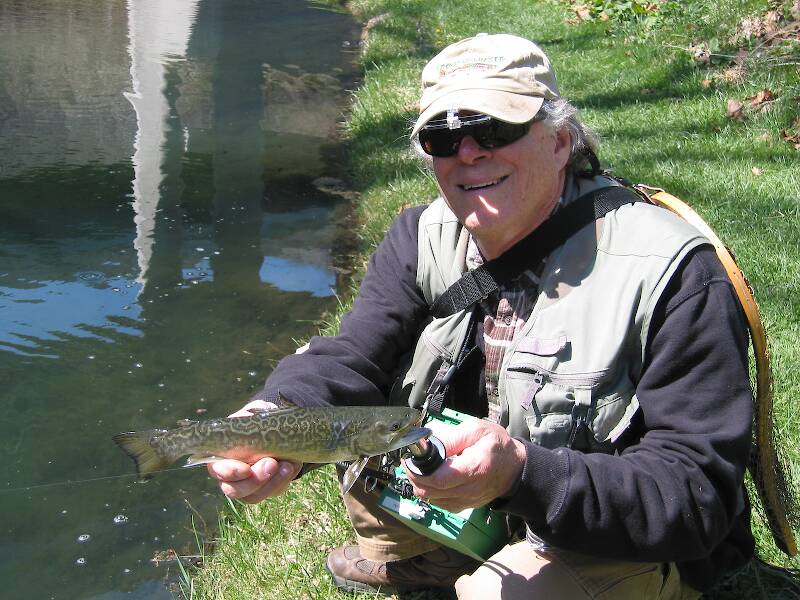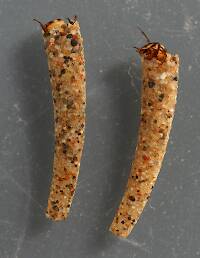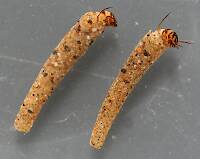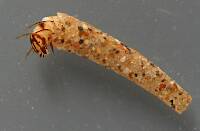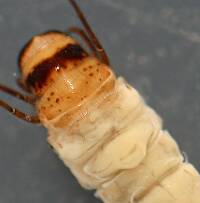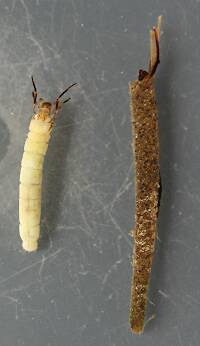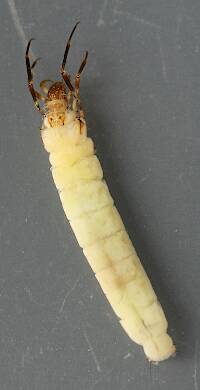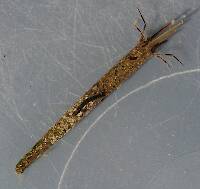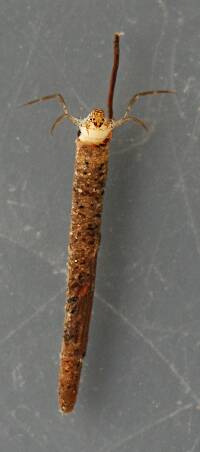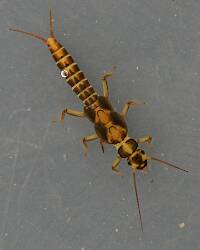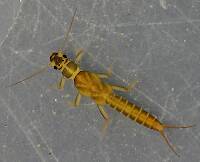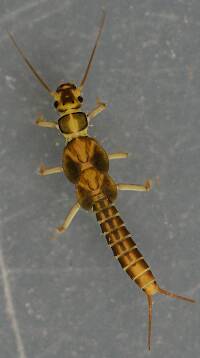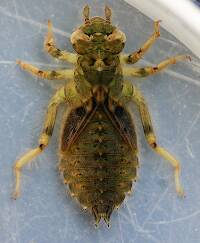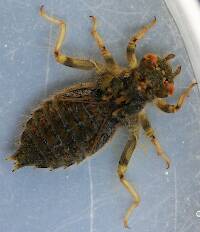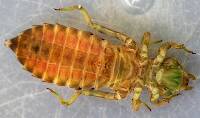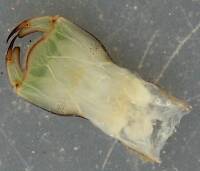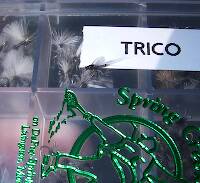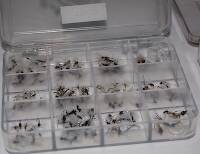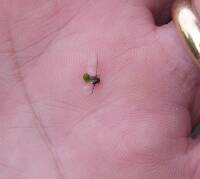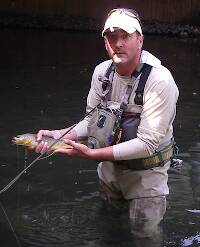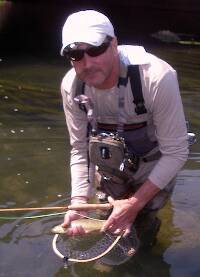
Hex Mayflies
Hexagenia limbata
The famous nocturnal Hex hatch of the Midwest (and a few other lucky locations) stirs to the surface mythically large brown trout that only touch streamers for the rest of the year.
Featured on the forum

This one seems to lead to Couplet 35 of the Key to Genera of Perlodidae Nymphs and the genus Isoperla, but I'm skeptical that's correct based on the general look. I need to get it under the microscope to review several choices in the key, and it'll probably end up a different Perlodidae.

Troutnut is a project started in 2003 by salmonid ecologist Jason "Troutnut" Neuswanger to help anglers and
fly tyers unabashedly embrace the entomological side of the sport. Learn more about Troutnut or
support the project for an enhanced experience here.
Mad4Trout on Jul 3, 2011July 3rd, 2011, 2:40 pm EDT
I don't know why "Stoneflies of the United States" has such a limited range for Perlesta placida, but we (Madmen Chapter of TU) have collected them on the Mad River, Logan Co., OH. They were reported by Gaufin (1956, Ohio J. Sci. 56 (6):321-324) in numerous counties. They have been recorded more recently by Ohio EPA.
Troutnut on Jul 3, 2011July 3rd, 2011, 3:22 pm EDT
Thanks for the info, and welcome to the site!
Jason Neuswanger, Ph.D.
Troutnut and salmonid ecologist
Troutnut and salmonid ecologist
Taxon on Jul 3, 2011July 3rd, 2011, 3:57 pm EDT
Don-
The Valid Stonefly Names for North America page (maintained by Drs. B.P. Stark, R.W. Baumann, and R.E. DeWalt) contains the most reliable and up-to-date information with regard to stonefly taxonomy and state/province distribution.
The Valid Stonefly Names for North America page (maintained by Drs. B.P. Stark, R.W. Baumann, and R.E. DeWalt) contains the most reliable and up-to-date information with regard to stonefly taxonomy and state/province distribution.
Oldredbarn on Jul 5, 2011July 5th, 2011, 6:11 am EDT
Roger,
Thanks for the interesting link...That should keep me busy for awhile, eh!? :) Maybe even keep me busy enough to limit my verbosity on TroutNut ;)
One thing though. What's an "infraclass", "cohort", or "superorder"? Am I going to end up knowing these bugs on a first name basis?
Thanks Again!
Spence
Lately I have become a little "caddis" obsessed...Have you seen Ames' book? I have several "hatch charts" for Michigan and they all list different scientific names for what I think is the same damn bug...Its more than a little confusing. It doesn't become any clearer when I add in Gary LaFontaine's book or the hatch lists from Carl Richards' work on caddis before he passed...Will the real "Popcorn Caddis" please stand up?!
Thanks for the interesting link...That should keep me busy for awhile, eh!? :) Maybe even keep me busy enough to limit my verbosity on TroutNut ;)
One thing though. What's an "infraclass", "cohort", or "superorder"? Am I going to end up knowing these bugs on a first name basis?
Thanks Again!
Spence
Lately I have become a little "caddis" obsessed...Have you seen Ames' book? I have several "hatch charts" for Michigan and they all list different scientific names for what I think is the same damn bug...Its more than a little confusing. It doesn't become any clearer when I add in Gary LaFontaine's book or the hatch lists from Carl Richards' work on caddis before he passed...Will the real "Popcorn Caddis" please stand up?!
"Even when my best efforts fail it's a satisfying challenge, and that, after all, is the essence of fly fishing." -Chauncy Lively
"Envy not the man who lives beside the river, but the man the river flows through." Joseph T Heywood
"Envy not the man who lives beside the river, but the man the river flows through." Joseph T Heywood
GONZO on Jul 5, 2011July 5th, 2011, 9:29 am EDT
Mad4Trout,
The USGS/NPWRC distribution listings are somewhat notorious for being in need of updating for many aquatic species.
Although you may well have Perlesta placida in OH, the taxonomy of Perlesta has grown like topsy in the past twenty years or so. At the time of Gaufin's report, many (if not most) specimens of Perlesta would probably have keyed to P. placida in the taxonomic scheme of the day. When Stanley Jewett provided the stonefly keys found in McClane's New Standard Fishing Encyclopedia (1974), Perlesta was considered to be "one species; east of the Rocky Mountains; abundant" (i.e. P. placida). Since then, the genus has grown to include about 24 NA species (see the reference that Roger cites above), and Gaufin's report may have been attributed to one of the "new" (or reinstated) species at a later time. Currently (according to the Stark, Baumann, and DeWalt listing), P. adena, P. decipiens, P. nitida, and P. teaysia are reported from OH, but this does not preclude the possibility that P. placida is also present.
It does mean, however, that making a positive determination of placida is probably much more complicated than it was at the time of Gaufin's report. Those who are working on the "Perlesta problem" are often reluctant to make a species determination without both adult male and egg-bearing female specimens. Some of the current Perlesta species are distinctive enough to be identified without this, but to say that the taxonomy of Perlesta is currently in flux would be an understatement.
Spence,
"Popcorn Caddis" seems to be a fly-fisher's common name that may not refer to a single species. Most often, it is applied to Brachycentrus species and joins a list of common names that includes "Grannom," "Shadfly," "Black Caddis," "Mother's Day Caddis," and "Apple Caddis." Some of these can have more or less specific meanings ("Grannom" is often used generically, "Apple Caddis" is most often applied to B. appalachia, and "Mother's Day Caddis" is most often applied--in the West--to B. occidentalis), but local usage often varies from stream to stream (and from individual to individual).
Best,
Lloyd
PS--BTW, all of Thomas Ames' books are excellent.
The USGS/NPWRC distribution listings are somewhat notorious for being in need of updating for many aquatic species.
Although you may well have Perlesta placida in OH, the taxonomy of Perlesta has grown like topsy in the past twenty years or so. At the time of Gaufin's report, many (if not most) specimens of Perlesta would probably have keyed to P. placida in the taxonomic scheme of the day. When Stanley Jewett provided the stonefly keys found in McClane's New Standard Fishing Encyclopedia (1974), Perlesta was considered to be "one species; east of the Rocky Mountains; abundant" (i.e. P. placida). Since then, the genus has grown to include about 24 NA species (see the reference that Roger cites above), and Gaufin's report may have been attributed to one of the "new" (or reinstated) species at a later time. Currently (according to the Stark, Baumann, and DeWalt listing), P. adena, P. decipiens, P. nitida, and P. teaysia are reported from OH, but this does not preclude the possibility that P. placida is also present.
It does mean, however, that making a positive determination of placida is probably much more complicated than it was at the time of Gaufin's report. Those who are working on the "Perlesta problem" are often reluctant to make a species determination without both adult male and egg-bearing female specimens. Some of the current Perlesta species are distinctive enough to be identified without this, but to say that the taxonomy of Perlesta is currently in flux would be an understatement.
Spence,
"Popcorn Caddis" seems to be a fly-fisher's common name that may not refer to a single species. Most often, it is applied to Brachycentrus species and joins a list of common names that includes "Grannom," "Shadfly," "Black Caddis," "Mother's Day Caddis," and "Apple Caddis." Some of these can have more or less specific meanings ("Grannom" is often used generically, "Apple Caddis" is most often applied to B. appalachia, and "Mother's Day Caddis" is most often applied--in the West--to B. occidentalis), but local usage often varies from stream to stream (and from individual to individual).
Best,
Lloyd
PS--BTW, all of Thomas Ames' books are excellent.
Taxon on Jul 5, 2011July 5th, 2011, 9:32 am EDT
Hi Spence,
You are welcome. Even though most (if not all) of the questions you posed are quite obviously rhetorical in nature, your punishment for having voiced them will be my answering them as though they were serious.
Infraclass: the taxonomic level immediately subordinate to Subclass in the hierarchy of zoological classification.
Superorder: is the taxonomic level immediately superior to Order in the hierarchy of zoological classification.
Cohort: (simplistically) of the same generation
Not unless you completely discontinue use of common names.
Only very briefly, but it's high on my "must acquire" list.
You are welcome. Even though most (if not all) of the questions you posed are quite obviously rhetorical in nature, your punishment for having voiced them will be my answering them as though they were serious.
Infraclass: the taxonomic level immediately subordinate to Subclass in the hierarchy of zoological classification.
Superorder: is the taxonomic level immediately superior to Order in the hierarchy of zoological classification.
Cohort: (simplistically) of the same generation
Am I going to end up knowing these bugs on a first name basis?
Not unless you completely discontinue use of common names.
Have you seen Ames' book?
Only very briefly, but it's high on my "must acquire" list.
Oldredbarn on Jul 5, 2011July 5th, 2011, 10:13 am EDT
You are welcome. Even though most (if not all) of the questions you posed are quite obviously rhetorical in nature, your punishment for having voiced them will be my answering them as though they were serious.
Roger,
I love ya man! My first wife used to tell folks, "He always makes it sound like he's just joking, but he's dead serious...He's just hedging his bets."
I thank you again and it's clear as mud! I promise you I will spend a little time on it before I "bother" you with any more of my serious questions? ;)
I have a nephew who has a form of aspergers. Even though he is quiet bright and a math wiz-kid he is literally incapable of knowing when uncle Spence is pulling his leg...As you might expect, knowing me as you do from this forum, I have a hard time always being "straight" and I'm very careful to make sure I haven't left him up in the air about something.
So, just to make sure you "got it", my joke about knowing the bugs on a first name basis was something like Joe, Jim, Bob, & Tony, and not E dorothea, dorothea. :)
I think us half-crazed anglers with their toes dangling ever so slightly in the entomological world must drive you "bug boys" crazy...Like finger nails across a chalk board.
I do get it that everything is somewhat in flux...I understand this really. I guess, having a dutch-german background, I just prefer my corners more square. I should probably just sit back and enjoy the ride...It's my problem really, not science's...verstehen?
Spence
Thanks again for your link to the clasifacation of the L recurvata...So. All our mayflies would basically have the same categories through the "Order" and everything below that is more and more descriptive of the particular bug. Its charateristics as opposed to other species.
"Even when my best efforts fail it's a satisfying challenge, and that, after all, is the essence of fly fishing." -Chauncy Lively
"Envy not the man who lives beside the river, but the man the river flows through." Joseph T Heywood
"Envy not the man who lives beside the river, but the man the river flows through." Joseph T Heywood
Oldredbarn on Jul 5, 2011July 5th, 2011, 10:28 am EDT
"Popcorn Caddis" seems to be a fly-fisher's common name that may not refer to a single species.
Mr. G,
I know this to be true. In fact I have heard anglers call a bug on the Mainstream a "Popcorn Caddis" and a friend of mine who has always referred to another bug, a smaller bug, as the same thing on the North Branch...Both of them were labelled such because during their egg laying they seem to "pop" over and over and bang rather firmly on to the surface in an attempt to dislodge their eggs. I guess a great many different caddis could, by this logic, be called a "popcorn caddis".
On a slightly different topic...In my post called "More Bugs" from my trip up in May I posted a caddis. I know it's not the greatest shot etc, but I'm wondering, after considering it some more, if that bug might not have been the so-called "White Miller" Nectopsyche albida? I was up near the end of May and I know that most of the local charts discuss this fly as a mid-summer to summer emergence. I found a photo that roughly appears to be the same bug.
What do you think?
Spence
I've ordered the Ames book on caddis.
"Even when my best efforts fail it's a satisfying challenge, and that, after all, is the essence of fly fishing." -Chauncy Lively
"Envy not the man who lives beside the river, but the man the river flows through." Joseph T Heywood
"Envy not the man who lives beside the river, but the man the river flows through." Joseph T Heywood
Creno on Jul 5, 2011July 5th, 2011, 1:59 pm EDT
Spence - For some reason I have had lots of time to follow a couple of the forums recently and saw your note below in a stony taxonomy thread. I went back looking for More Bugs and only found a hydropsychid in that thread. What did I miss?
creno
creno
Entoman on Jul 5, 2011July 5th, 2011, 2:02 pm EDT
Hi Spence,
No it's not Nectopsyche for a variety of reasons that can be determined from the photo. From a practical stand point, your original suggestion of Cheumatopsyche or Little Sister Sedge was probably the correct one, though regional differences probably have it going by a different common name. But that's a loose "probably". Local hatch information on that particular stretch of river is hopefully available to add more certainty to your opinion.
Regards,
Kurt
...but I'm wondering, after considering it some more, if that bug might not have been the so-called "White Miller" Nectopsyche albida?
No it's not Nectopsyche for a variety of reasons that can be determined from the photo. From a practical stand point, your original suggestion of Cheumatopsyche or Little Sister Sedge was probably the correct one, though regional differences probably have it going by a different common name. But that's a loose "probably". Local hatch information on that particular stretch of river is hopefully available to add more certainty to your opinion.
Regards,
Kurt
"It's not that I find fishing so important, it's just that I find all other endeavors of Man equally unimportant... And not nearly as much fun!" Robert Traver, Anatomy of a Fisherman
GONZO on Jul 5, 2011July 5th, 2011, 2:18 pm EDT
What do you think?
I don't think so, Spence. The similarities seem slight and superficial to me (and the tibial spur formula for Nectopsyche is usually 0-2-2). Compare to Jason's Nectopsyche photo:
http://www.troutnut.com/fullsize/picture-im_extax/67
PS--I see that Dave and Kurt have already responded. I'll cast my lot with those who think that your photo is probably of a hydropsychid, though I'd be hard pressed to prove it. :)
Oldredbarn on Jul 6, 2011July 6th, 2011, 6:35 am EDT
Ha! You won't believe what I just did...I just composed the best damn post I ever wrote...I was taking no prisoners and I timed out and lost it...Saved by my own verbosity! I would of been sued anyway! :)
I am taking this as a sign from the river gods that I'd better just settle myself down!
To keep it short but sweet...I was using a photo for my "guess" from the anniversary edition of "Selective Trout"...the same volume where they show a caddis emergence chart twice, the exact same one, for mid-west & western streams...Could of used an editor there...I'll look up the page where the photo appears and it could very easily have been mislaballed...
Enough said!
I guess it's like quoting USA Today when I should of looked in the New York Times...After all this I chided myself for going on like I did and driving this thread away from Mad4Trout's original intent. Verzeihen Sie mir!
Spence
I'm heading off for my second cup of Earl Grey this morning...Care to join me?
I am taking this as a sign from the river gods that I'd better just settle myself down!
To keep it short but sweet...I was using a photo for my "guess" from the anniversary edition of "Selective Trout"...the same volume where they show a caddis emergence chart twice, the exact same one, for mid-west & western streams...Could of used an editor there...I'll look up the page where the photo appears and it could very easily have been mislaballed...
Enough said!
I guess it's like quoting USA Today when I should of looked in the New York Times...After all this I chided myself for going on like I did and driving this thread away from Mad4Trout's original intent. Verzeihen Sie mir!
Spence
I'm heading off for my second cup of Earl Grey this morning...Care to join me?
"Even when my best efforts fail it's a satisfying challenge, and that, after all, is the essence of fly fishing." -Chauncy Lively
"Envy not the man who lives beside the river, but the man the river flows through." Joseph T Heywood
"Envy not the man who lives beside the river, but the man the river flows through." Joseph T Heywood
Mad4Trout on Nov 26, 2011November 26th, 2011, 5:36 pm EST
Thanks to Lloyd and Roger for comments on my Perlesta placida posting back in July. It's been a while since I've visited the Troutnut site (6 months!) so I apologize for not responding sooner. I meant to give the name as "Perlesta placida complex" and didn't mean to specify the species. Indeed, we have only collected nymphs, not adults, so we can't be sure of a species. In perusing the Ohio EPA Macroinvertebrate Collection list only one Perlesta is listed, "P. placida complex"; which could include the other species listed for Ohio by Stark, Baumann and DeWalt (and not necessarily P. placida). I will add that I am pursuing the matter by going after the adults and by setting up a cold water aquarium to rear them out. Hopefully I can get it down to the species.
By the way, the only other stoneflies that we have collected so far from the Mad River (one of the few trout streams in Ohio, outside of the Lake Erie watershed) are Taeniopteryx burksi (found in December) and Leuctra sp. (found August). We are surprised to find so few.
Anyway, I look forward to the comments.
All the best,
Don
By the way, the only other stoneflies that we have collected so far from the Mad River (one of the few trout streams in Ohio, outside of the Lake Erie watershed) are Taeniopteryx burksi (found in December) and Leuctra sp. (found August). We are surprised to find so few.
Anyway, I look forward to the comments.
All the best,
Don
Taxon on Nov 26, 2011November 26th, 2011, 9:41 pm EST
Hi Don-
Please don't be offended, but going after adult stoneflies and placing them in an aquarium to "rear them out" seems a bit illogical. Is that what you really intended to say?
I will add that I am pursuing the matter by going after the adults and by setting up a cold water aquarium to rear them out.
Please don't be offended, but going after adult stoneflies and placing them in an aquarium to "rear them out" seems a bit illogical. Is that what you really intended to say?
Mad4Trout on Nov 27, 2011November 27th, 2011, 6:30 am EST
Roger,
No, I meant I will collect adults to ID and collect the nymphs to rear in the aquarium.
Don
No, I meant I will collect adults to ID and collect the nymphs to rear in the aquarium.
Don
Quick Reply
Related Discussions
Topic
Replies
Last Reply
6
Aug 22, 2010
by Lastchance
by Lastchance
1
Oct 28, 2008
by GONZO
by GONZO


